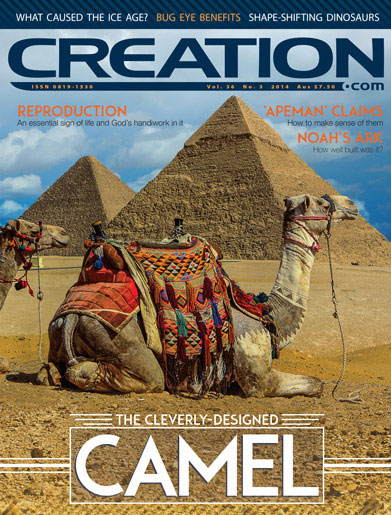Robot designers want to copy the hummingbird
Engineers at Japan’s Chiba University who aim to build miniature flying robots want to copy bird wing flexibility and movement in their designs.1

They chose the hummingbird2 as their ‘wing model’ because its capacity to hover quite still while feeding on nectar means they can be studied more easily than other birds. “And they’re quite small,” explained researcher Masateru Maeda, who used high-speed cameras to capture the way that the hummingbird precisely bends and flexes its wings, adding, “Larger birds that cannot hover have to be studied in wind tunnels.”1
The researchers found that the movement of the primary flight feathers changes the shape and size of the wings to precisely control the lift they generate.
This research project is but one of many around the world where engineers are seeking to incorporate evident design features in nature into their own designs. Not just in the expanding field of micro air vehicles (MAVs)3,4,5,6,7 but also in a host of terrestrial and aquatic enterprises. E.g. ceiling-walking lizards and insects are inspiring scientists to make detachable super-adhesives, for applications such as window-cleaning robots;8,9 desert creatures are providing the inspiration for improvements to machines that have to traverse sandy terrain;10 fish and even single-celled organisms are inspiring better submarines.11,12 And just as no-one should dispute that the resulting robots and other machines have been intelligently designed, nor should anyone dispute that design in nature wasn’t ‘by chance’ either (Romans 1:20). For more, see creation.com/biomimetics.
References and notes
- Gill, V., Hummingbirds’ wings ‘shape-shift’, bbc.co.uk, 4 July 2013. Return to text.
- Dreves, D., The hummingbird: God’s tiny miracle—If you operated at this energy level, you would burst into flames!, Creation 14(1):10–12, 1991; creation.com/hummingbird. Return to text.
- Usherwood, J. and Lehmann, F., Phasing of dragonfly wings can improve aerodynamic efficiency by removing swirl, Journal of the Royal Society Interface, doi:10.1098/rsif.2008.0124, 13 May 2008; also see Catchpoole, D., Dragonfly design tips, Creation 32(2):51, 2010; creation.com/dragonfly2. Return to text.
- Phillips, N., Locust wings to inspire flying robots, abc.net.au, 18 September 2009; also see Catchpoole, D., Lessons from locust wings, Creation 33(4):56, 2011; creation.com/locust-wings. Return to text.
- Butterflies point to micro machines, news.bbc.co.uk, 13 January 2003; also see Catchpoole, D., Why a butterfly flutters by, Creation 26(2):56, 2004; creation.com/butterfly-flutter. Return to text.
- Carruthers, A., et al., Use and Function of a Leading Edge Flap on the Wings of Eagles, 45th AIAA (American Institute of Aeronautics and Astronautics) Aerospace Sciences Meeting and Exhibit, 8–11 January 2007, Reno, Nevada, aiaa.org; also see Catchpoole, D., Amazing discovery: Bird wing has ‘leading edge’ technology, Creation 30(4):53, 2008; creation.com/flaps. Return to text.
- Fox, D., Electric Eye, New Scientist 171(2305):38–42, 25 August 2001; also see Sarfati, J., Can it bee?, Creation 25(2):44–45, 2003; creation.com/bee. Return to text.
- Geim, A., et al., Microfabricated adhesive mimicking gecko foot-hair, Nature Materials 2:461–463, 2003; also see Sarfati, J., Gecko foot design—could it lead to a real ‘spiderman’?, Creation 26(1):22–23, 2003; creation.com/geckoman. Return to text.
- Gorb, S., et al., Insects did it first: a micropatterned adhesive tape for robotic applications, Bioinspiration & Biomimetics 2(4):S117–S125, 2007; also see Catchpoole, D., Walking up walls—Insects inspire a better ‘sticky tape’, creation.com/walking-up-walls, 2 May 2008. Return to text.
- Berardelli, P., One Giant Leap for Robot-Kind, news.sciencemag.org, 9 February 2009; also see Catchpoole, D., Desert creatures inspire ‘SandBot’, Creation 33(2):53, 2011; creation.com/sandbot. Return to text.
- Trafton, A., MIT team building robotic fin for submarines, web.mit.edu, 30 July 2007; also see Catchpoole, D., Submarines with fish fins?, Creation 31(3):21–23, 2009; creation.com/submarines. Return to text.
- Wakefield, J., Mimicking Mother Nature, Scientific American 286(1):24–25, 2002; also see Sarfati, J., ‘Primitive’ cell inspires advanced robot mini-sub, creation.com/microhunter. Return to text.




Readers’ comments
Comments are automatically closed 14 days after publication.